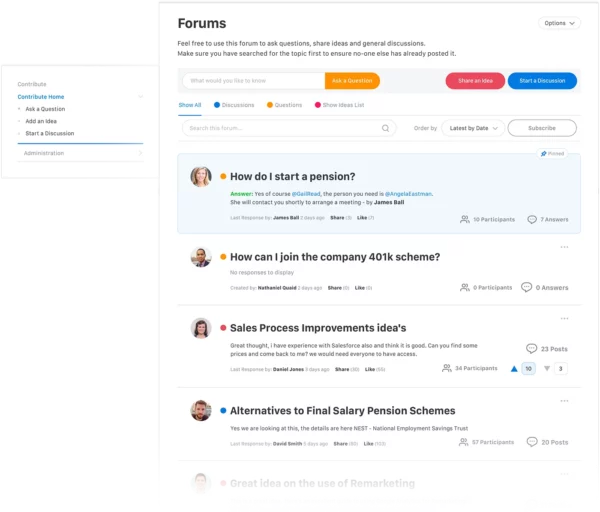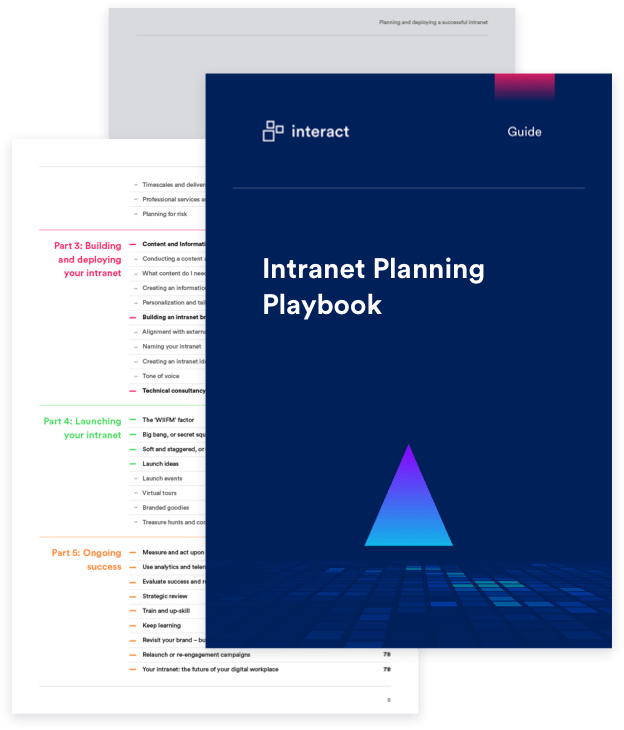Innovations and ideas can come from anywhere in an organization. Sometimes, purely by accident, ideation, innovation, and intrapreneurship create moments of significant change (and profitability) for businesses. Employees can spot opportunities for change and growth, but how can organizations get ideas from employees?
In 1968, 3M employee Spencer Silver was trying to develop a super-strong adhesive when he accidentally came up short.
Despite pitching the resulting light adhesive for years, it took until 1974 before colleague Art Fry spotted the potential, to hold a bookmark in place in his hymnbook. In 1980, the Post-it Note was born and a new direction for the business emerged.
Although most businesses have a similar pool of bright, innovative employees to pull from, they fail to capture ideas from employees because they lack an employee listening strategy and a dedicated employee idea management process.
An Intranet Gives Your Employees A Platform To Contribute
Why gather ideas from employees?
Trends come and go, but companies always need to innovate to remain commercially relevant.
We also need to look beyond the boardroom. Innovation doesn’t just benefit the bottom line by enabling you to enter new markets or produce new products, it has a demonstrable impact on employee productivity.
Studies show that listening to employees improves happiness levels at work, which also improves levels of employee engagement and productivity.
Despite the benefits of innovation, McKinsey found that 65% of senior executives weren’t confident about the decisions they need to make to stimulate innovation.
Our 10-step plan can help you get started on the road to transformative employee listening, idea management, and innovation.
1. Step one: Lead from the front
Innovation may happen by chance, as the Post-it Note story shows, but to make it an integral part of business culture, it needs to be recognized and formally integrated into the strategic management agenda of your business.
Simply put, you need to get those at the top involved in gathering ideas from employees too.
Meet with senior management and pitch the need for innovation management, as you would any business initiative. Get buy-in from those who will champion innovation and act as channels for gathering and communicating ideas from employees.
“CEOs are now taking personal responsibility for directing and inspiring innovation as it becomes an ever more vital element of business survival and success.” (Source: PwC, ‘Unleashing the power of innovation’)
Sharing this approach will lay the foundation for creating an essential mind-shift to allow you to hear what’s being shared. If you believe you have all the answers or innovation can only come from the C-suite, you have no reason to listen to others.
2. Step two: Determine what’s stopping you
Innovation may be pushing its way up the management agenda, but evidence suggests it isn’t filtering into the body of organizations.
Before we can get the wheels of innovation truly turning, evaluate what barriers are preventing your business from accessing and implementing fresh ideas. The best approach to identify these is to crowdsource employee ideas.
Using surveys, focus groups, or open discussion on your company communication channels, put the question to management and employees; Where are the barriers?
Once you have an idea of where the challenges lie, you’re better equipped to tackle them.
According to PwC, the top-ranking constraint was financial resources. Working innovation into the annual budget requires senior-level buy-in. If your business has ideation on the agenda, this one is more easily addressed. The rest we explore in the following steps.
3. Step three: Create the right motivation and culture
“The key ingredient is creating an organizational culture that encourages innovation in all areas.”(PwC)
Changing and evolving business culture continues to rank as one of the biggest HR headaches. However, the consensus is clear: innovation is only possible in the right environment.
Money as a motivator doesn’t deliver perfect results. Good ideas may be generated by those who demonstrate a level of pride in both their organization and their personal accomplishments too.
Start by defining and communicating your business mission, values, and strategic direction. If your employees know where you’re headed, they’re more likely to contribute ideas of value to your business. Don’t use money as the incentive; place emphasis instead on that employee’s potential to shape the future direction of the business and make a meaningful contribution.
Listen, acknowledge, and give feedback to employees who submit ideas. As a member of management, beware of jumping the gun and adding suggestions or changes to ideas as soon as they’re submitted; this can give the impression to employees that their ideas don’t have merit or aren’t good enough, reducing the likelihood of them repeating the behavior.
Remember that an idea is only the first step, and it will be imperfect and require fine-tuning. Embrace that concept and adopt the philosophy of ‘there’s no such thing as a bad idea’. Even if you must say no to an employee, their suggestion may lead to other developments in the future. It’s vital to establish a culture in which employees can feel confident submitting ideas, in the knowledge that they will be listened to and not judged.
94% of senior executives agree that people and corporate culture are the most important drivers of innovation.
An Intranet Gives Your Employees A Platform To Contribute
4. Step four: ASK for ideas from employees and establish a process
Do your employees even know that you want them to step up?
Make it clear that your organization is seeking input from its employees and communicate it widely. Combine top-down appeals on your company intranet software with peer-to-peer comms, manager cascades, or other internal communication channels. Even the act of stating it will put idea creation on your employees’ radar.
However, a blank slate can prove daunting to many. Direct innovation to ensure you get the most from your employees. Rather than simply saying “We want your ideas”, identify and define the areas you need support with. Give your employees a structure and process to follow, or consider having a member of the management team ‘get the ball rolling’ with the first suggestion.
For example, establish an ‘ideas’ forum on your intranet or use a dedicated idea management platform. Start a discussion requesting ideas for a specific process, product, or objective and outline how the process will follow through. Assigning a timescale can prove beneficial; it creates a sense of ‘urgency’ that will prompt or trigger suggestions, rather than an open-ended process. This sets out expectations and offers employees a starting point and structure for putting forward ideas.
5. Step five: Give them the tools
Lack of adequate technology and upward communication pathways can restrict the ability of employees to make their voices heard. Let’s also not forget that ‘two heads are better than one’. Do employees have adequate means to communicate and collaborate with their colleagues?
Ensure employees have ways to put their ideas forward and connect effectively. Social tools such as ESNs, intranets, collaboration tools, or even specialized brainstorming apps can all support more effective idea generation while connecting individuals regardless of their location or department.
Consider creating dedicated groups to tackle specific challenges, ensuring you bring together a diverse range of employees from multiple levels of experience and departments. Differing perspectives will help challenge the status quo and bring about fresh ideas and approaches. Provide the necessary virtual space, such as a team area, for those individuals to brainstorm and innovate.

6. Step six: Make time for innovation
Google famously adopted a ‘20% time’ policy for innovation, allowing its engineers to dedicate 20% of their time to personal projects. The initiative generated some of Google’s most successful products including Gmail, AdSense, and GoogleTalk. Although the concept has since been replaced with a more focused approach, it highlights the need to dedicate time to ideation.
While not all organizations can afford the productivity losses of a ’20 time’ approach, ensure that alongside ad-hoc ideation along your communication channels, there is time dedicated to purposeful brainstorming and idea creation.
This may be a weekly, monthly, quarterly, or annual event, depending on your business needs; setting up a regularly occurring event for an open forum, group discussion, or even just as a reminder to employees to submit ideas can help get those creative ideas going.
An Intranet Gives Your Employees A Platform To Contribute
7. Step seven: Think outside the box
Ideation is, by definition, a creative process. So why not get creative with how you stimulate ideas?
Some of our favorites include the fail-safe ideas box, doodles, mood boards (the continued popularity of Pinterest can translate into business ideation, creating a digital mood board to stimulate innovation), word games, or even improv games, a technique explored in this Hubspot blog.
Why not assign an ‘ideas wall’ and supply a bank of Post-its? Or have a ‘think like the customer’ session, using role-play or even actual customers? Keep it fun: if your employees feel comfortable, they’re more likely to contribute.
Remember that not all employees create or innovate in the same way; offering several channels or options can help get the maximum number of ideas from the maximum number of people.
Include confidential channels, where employees can elect to submit ideas anonymously; for those who have reservations about putting their name against an idea, this offers reassurance.
8. Step eight: Stop and listen
You’ve made the decision to innovate. You’ve removed barriers, you’ve asked for ideas, you’ve given them the tools. Now, you need to listen.
Employees are continuously talking, even outside of structured innovation campaigns. The act of creating a true culture of innovation calls for continuous listening – both to active ideation channels, such as your ideas forum or within brainstorming sessions, and to ‘passive’ conversations, which naturally occur in your business.
This is where a centralized digital workplace can prove valuable: by bringing together employee conversations on a searchable platform, such as an intranet, managers are empowered to access information and knowledge that may previously have been lost in emails.
Make sure you listen from the bottom up; some of the most powerful insights can be found on the frontlines of your business, from those actively delivering your product or service. Ideation isn’t an executive-level task: when it comes to innovation, every employee counts.
9. Step nine: Consider a role swap or shadowing
When we turn up to work and complete our core roles day in, day out, we can get siloed into our own departments and lose sight of the bigger picture. Never underestimate the power of a fresh pair of eyes.
Tap into the wider business and have ‘outsiders’ evaluate other functions, departments, or processes. Consider a ‘buddying’ program to link individuals from different parts of the organization to collaborate. Often, the answer to a business challenge already exists elsewhere in your company; it’s simply a question of tapping into that knowledge.
Utilize newcomers; coming from a different organization offers a unique insight that many organizations fail to fully capitalize upon. For existing employees, some practices are so fully embedded into the business that no one questions or challenges them, let alone suggests alternatives.
Emerald Technologies, a biotech startup, describes how their use of “fresh-eye journals” for new starters help them identify areas for improvement and fresh ideas for their organization.
10. Step ten: Tell the story
If you’ve had an employee idea actioned, shout about it. Telling the story not only provides valuable recognition for the individual(s) who put forward the idea but shows that ideas truly can come from anywhere—prompting other employees to follow suit.
Make a big deal of internal storytelling by pushing the story across your company intranet, email, or newsletters. If you can, give an overview of how the idea evolved to become an action within the business and describe the value – perceived or actual – that idea has brought to your organization.
If you can use a company blog on your intranet software with social tools such as liking, sharing, or commenting, this enables other employees to engage and share the experience. Celebrating successful ideas is perhaps one of the most powerful things we can do to embed ideation in business.





